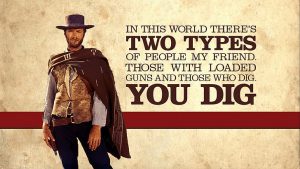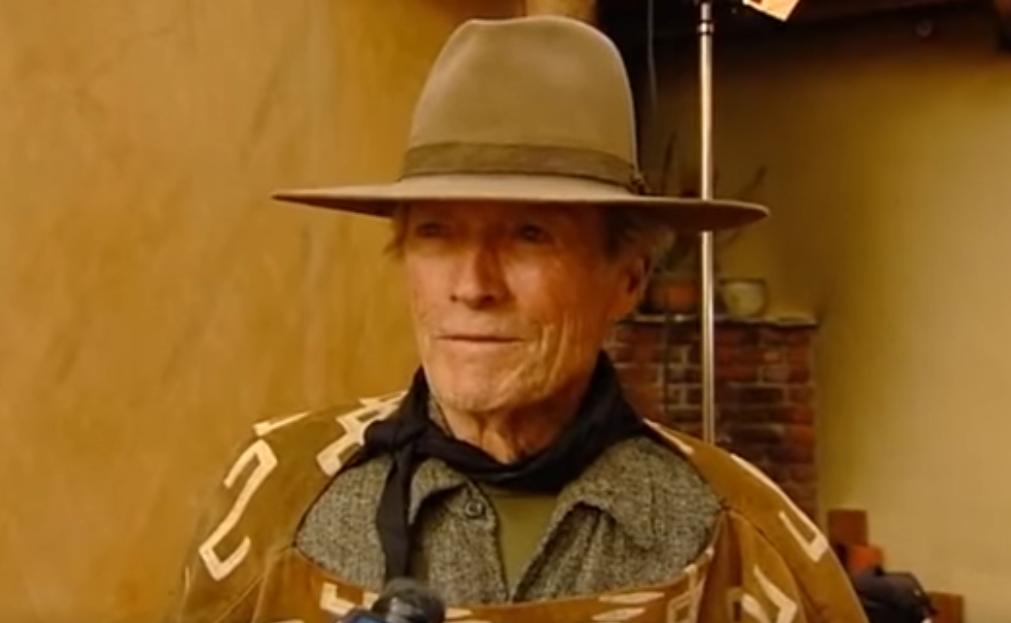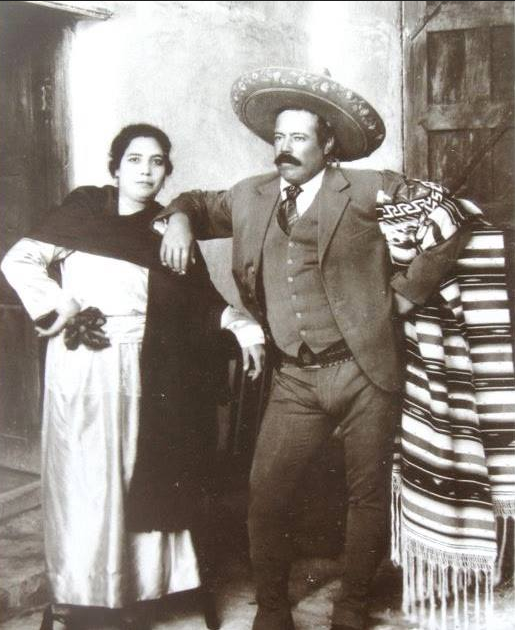 I’ve always been a fan of Clint Eastwood
I’ve always been a fan of Clint Eastwood
and my favorite movies of his are “The Good, The Bad and the Ugly“, “For a Fist Full of Dollars“, “Two Mules For Sister Sarah” and “Pale Rider”.
Eastwood played the same type of character in many of his movies, each with a different name and story, but always the same sort of gritty, confident and no nonsense cowboy on a mission to do what was right.
I always loved the ponchos that Clint wore as he played his various characters in the movies and was struck by how well they went together with the story lines for the movies. A key “character” in his movies was the poncho which literally became a part of Eastwood’s character.
 Recently, I was watching Bill Murray in “Groundhog Day” with the scene of him arriving at the movies with a blonde woman dressed as a french maid and him in the Clint Eastwood poncho get up.
Recently, I was watching Bill Murray in “Groundhog Day” with the scene of him arriving at the movies with a blonde woman dressed as a french maid and him in the Clint Eastwood poncho get up.
He played the Clint Eastwood character to a tee and one wonders if Murray would have been a mainstay in Spaghetti Westerns if he had applied himself to those sorts of films.
So, right then, as I watched Groundhog Day, I wondered about the story behind Clint’s classic prop of the poncho and his iconic hat and decided to research if these types of clothing were actually used in the Old West. Additionally I wondered how applicable these clothes are in today’s world as useful clothing and moreover, as essential survival gear. Finally, I wondered if I, a middle aged guy, retired and not in the prime of life could use these clothes in my own survival camp and missions.
 I researched a couple of articles on Eastwood’s movie clothes and found the following at truewest.com: “the authenticity of Eastwood’s poncho is never questioned on screen. Yet folks still dispute who brought the poncho to the movie set. Eastwood contends he bought the poncho, his hat and other wardrobe essentials in California before shooting the movies in Italy and Spain. Others associated with the film claim the poncho was acquired in Spain”
I researched a couple of articles on Eastwood’s movie clothes and found the following at truewest.com: “the authenticity of Eastwood’s poncho is never questioned on screen. Yet folks still dispute who brought the poncho to the movie set. Eastwood contends he bought the poncho, his hat and other wardrobe essentials in California before shooting the movies in Italy and Spain. Others associated with the film claim the poncho was acquired in Spain”
 It turns out that poncho still exists and Clint owns it. I suspect that he is telling the truth that he bought the poncho and wore it for all three films of the “Dollars” movies. In an article on Eastwood at Outsider.com:
It turns out that poncho still exists and Clint owns it. I suspect that he is telling the truth that he bought the poncho and wore it for all three films of the “Dollars” movies. In an article on Eastwood at Outsider.com:
“Eastwood revealed he kept the piece of clothing and hadn’t unfolded it since filming. But more recently on This Morning, Eastwood told host Alison Hammond that he’s finally displayed the clothing”
“I still have that, yeah… it’s sitting in a glass case. Never been washed” Eastwood said.” When asked if it was true that he wore the same unwashed poncho in the movies “A Fistful of Dollars (1964)”, “For a Few Dollars More (1965)”, and “The Good, the Bad and the Ugly (1996)”, He confirmed that this was indeed true.
He revealed that if it was washed, it would probably fall apart. It is an iconic bit of movie history and I am glad to see it still exists and is treasured. Some history of that poncho can be view HERE.
In a recent parade in downtown Carmel where he was mayor for two years, Eastwood may have worn sported a poncho that matched his classic “Dollars” movies. It is unclear if this was the original or a copy, but it was good to see him in it once again.
There seems to have been more than one poncho used in his other movies, but it is clear the one he bought for his The Good Bad and the Ugly movie and others is his favorite. It seems that fate brought these two together and made something that turned out to be more than just a part of a movie. It changed American life.

Eastwood’s poncho was likely a South American design and definitely would have been something that stood out against the backdrop of Mexican “ponchos” which had significant differences from the South American versions. However, it makes sense that people all over the Americas of the 1800s would have known of the South American version of the poncho and likely would have used it in daily life. Frankly, it is just too useful in that form to not have been popular.
Eastwood’s characters always seemed to be part of the Civil War era between the 1840s to the 1880s and it isn’t a stretch to imagine Western Cowboys were wearing these as essential survival kit in the cold desert environments of the Southwest United States. The notion that cowboys wore ponchos is something I could not determine in my research but it is clear they were available and likely were used by people from California to Arizona, New Mexico and Texas and likely many other parts of America. Given that the U.S. Army had a great affinity for ponchos in the form of rubberized and weatherproof garb, it is certainly clear that the evolution of the poncho captured the hearts of both civilians and military alike from the 19th century on into the modern day.
Ponchos come in every material you can name from incredibly cheap and thing plastic rain ponchos to rubber and plastic ponchos made from space age materials that provide amazing protection, warmth and comfort. This is a garment that will continue to evolve with us as time goes on.
Origin of the Poncho
Ponchos originated in South America and although is is often quoted that the Mapuche people were the originators of the garment, Wikipedia states that ” investigations have concluded that Ponchos’ origins could be Ecuador or Peru, It is not known where the first Ponchos were fabricated. Nowadays the poncho is commonly associated with the Americas. As traditional clothing, the local names and variants are:
- Ruana, in cold regions of Colombia and Venezuela.
- Poncho, most Spanish-speaking countries and worldwide.
- Pala or Poncho, in Brazil (mainly in the South).
- Chamanto, only in Central Chile, poncho in the north and south.
- Jorongo, usually larger or full-length, and often used for special occasions or horse-back riding.
- Gabán, typical in Michoacán, Mexico.
- Poncho chilote, a heavy woolen poncho of Chiloé Archipelago.”

Poncho Via and his wife shortly before his assassination in 1911. Note they are both wearing ponchos.
It is clear the popularity of ponchos came from their effectiveness for warmth because of the use of wool of alpacas and sheep in their manufacture. The use of ponchos spread north to Central America and then into North America proper.
Pancho Villa, the one-time bandit who became a Mexican General, wore a poncho and so too did his wife. From the look of the garb in the photo of the pair, they do not look too different from the ponchos available to us in the twenty first century. It is clear that these garb were well established and in vogue in 1911 when this image was taken.
South American versus Mexican Ponchos
I wondered what the South American perspective on ponchos was and found the video “Preppers Poncho” on the “South American Prepper” channel. He gives a good run down on what a makes for a good poncho. He also shows the significant differences between the South American and the Mexican versions of the poncho. The Mexican Poncho is more of a blanket that is wrapped around the body while the South American version has the hole for the head to allow it to be worn as clothing.
19th Century Poncho Tech
It is not at all hard to imagine a Civil War era cowboy discovering the unique abilities of the poncho to keep warm in cold desert and mountain climates and to prefer it to the canvas duster coats that were also common at that time.
When one thinks of ponchos in the modern day, a plastic or rubber garment is usually what comes to mind. However there is an increasing popularity of traditional wool ponchos that many who enjoy wearing them outdoors enjoy.

Men’s Gamboa Poncho Cloak with Hood – I own this particular poncho for everyday use.
From a survival aspect both the wool and rubberized or plastic ponchos are well received from the survival community. The military version’s available today are often used as survival shelters in addition as wearable clothing. The poncho does double-duty as a tarp, a classic pup tent and even as a wrap to sleep in.
In the article titled “Cowboy EDC: 16 Things Cowboys Carried With Them To Survive In The Wild West”, author states:
“I’ve even heard a few survivalists say that they would choose to have a poncho is they could only have one item to survive with, even over the best bushcraft blade.”
My Poncho System
I purchased my own alpaca wool poncho in October 2021 and was a little nervous at how light the material was and wondered if it would be much good since I intended to wear it in my outdoor work and also filming for my channel. I didn’t need to worry. Once I put it on and wore it inside and outdoors, it became clear this was an excellent item for keeping warm.
One of the things I’ve found with my poncho is that when my arms get cold, I can just put them inside the poncho and the trapped warm air is all that is needed to heat up my cold skin. Coupled with a military or camping poncho as an outside layer and this alpaca poncho as a inner layer, I suspect a person could be outside in the worst conditions and be perfectly warm and dry. I even use this poncho as a blanket and have to be careful because my cat absolutely does her best to take it over as a place to lay on!
As I write this article, I am wearing my poncho in a slightly cooler house. I am perfectly warm and comfortable as the alpaca wool keeps my core toasty warm. I have often sat down outside with a plastic tarp or blanket on the ground and spread out the poncho and it makes a perfect economical “tent” shelter to keep warm with just your body heat.
I envision using this poncho as an inside layer with a plastic poncho as the outer layer and will try that out and cover it in a future article/video.
Survival Ponchos
I always enjoy watching Corporals Corner and noted his review of the Helikon-Tex Swagman Roll Poncho. This is a premium priced poncho that costs around $169 U.S. This poncho is a multi role tool that can stand everything Mother Nature can throw at it. It is waterproof, warm and durable. It also serves as a blanket, a poncho (of course), a sleeping bag and even as an inner liner for a sleeping bag.
On YouTube, I recently saw a video by “Ranger Survival and Field Craft” that extolled the virtues of using a survival blanket as a near instant shelter with a candle to provide instant heat and shelter just about anywhere. While NOT a poncho video, I suspect that a poncho would be not far off of being a similar shelter but the idea of putting fire under my garment and worrying about catching fire would be a little much. Still, with a tea light candle, perhaps it would provide that instant shelter a little extra heat given wool being a little harder to catch fire. The big thing is SAFETY and to just be aware that such things can be done but your mileage may vary. If in doubt, forget the fire!
Conclusion
If anything can be said about ponchos it is that they are versatile. They can be a shelter, clothing, stylish, survival tools and everyday items anyone can use. They can be incredibly cheap plastic rain ponchos to prevent you from getting wet to advanced materials used by survivalists, campers and the military to ward off even the worst weather.
My favorite is the alpaca wool poncho that is authentically South American and which keeps impressing me the more I wear it. I highly recommend you look into them for your own warmth and needs be it everyday use, rain gear or survival essential. We will cover more of the poncho uses I am finding in a future video and I plan to discuss Clint Eastwood’s cowboy hat and talk survival and the quintessential cowboy hat in an upcoming article. Until then, stay warm!
